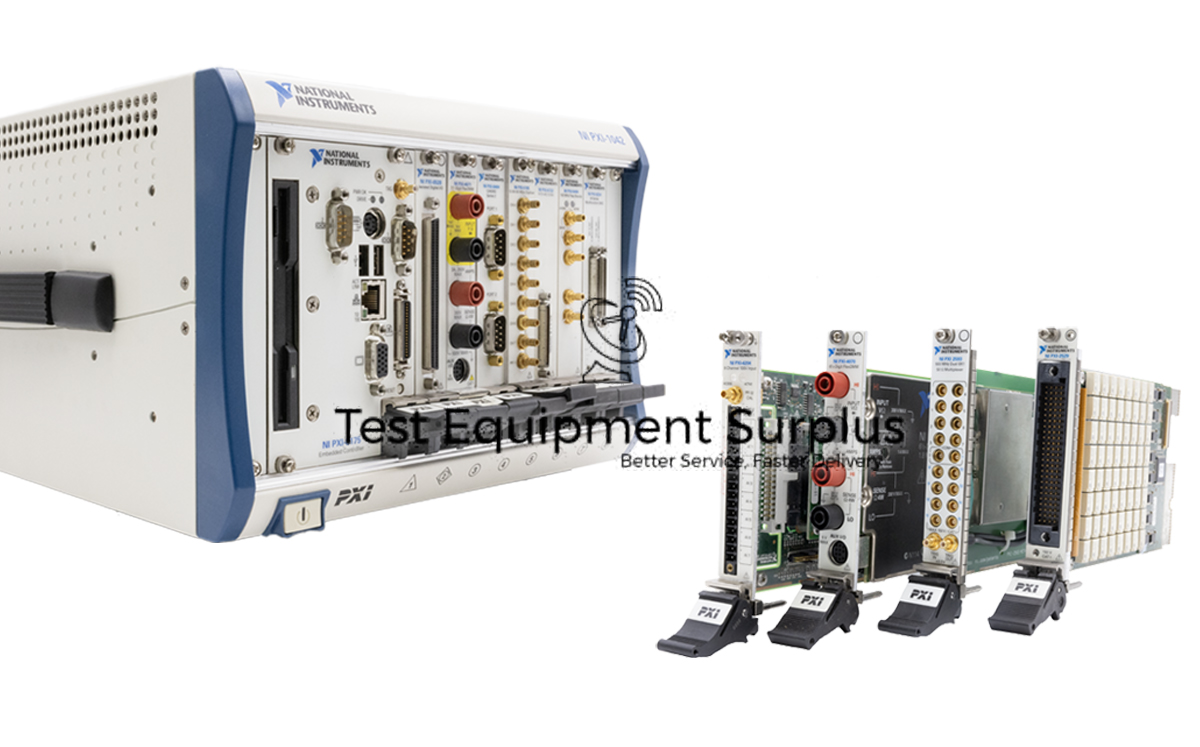Description
The National Instruments PXI-5671 PXI Vector Signal Generator is a sophisticated piece of equipment identified by part numbers 779079-02, 779079-03, and 779079-04 designed to suit a variety of RF signal generation needs. It is supported by the NI-RFSG instrument controller software, which is compatible with LabVIEW 7 Express, LabWindows/CVI, and C programming environments, making it a highly versatile tool for developers and engineers.
For those utilizing LabVIEW, the PXI-5671 is compatible with the Modulation Toolkit, which enhances its functionality by providing standard modulation functions like EVM (error vector magnitude), MER (modulation error ratio), and ρ (rho). Moreover, it includes features for injecting impairments into the signal, such as IQ Gain Imbalance, Quadrature Skew, and AWGN (additive white Gaussian noise), which are crucial for testing the resilience of communication systems under various signal conditions.
The PXI-5671 also comes equipped with advanced visualization tools including Trellis, Constellation, and 2D-and 3D-eye diagrams, allowing for detailed analysis and observation of the signal’s integrity and performance. Furthermore, with a deep memory depth of 256 MB, it can store and play back complex modulated signals, providing a maximum waveform duration of 1.28 seconds which is essential for the simulation of real-world signal transmission scenarios.
| Specification | Details |
|---|---|
| Product Name | National Instruments PXI-5671 PXI Vector Signal Generator |
| Part Numbers | 779079-02, 779079-03, 779079-04 |
| Instrument Controller Software | NI-RFSG (supports LabVIEW 7 Express, LabWindows/CVI, and C) |
| Modulation Toolkit Compatibility | LabVIEW |
| Standard Modulation Functions | EVM (error vector magnitude), MER (modulation error ratio), ρ (rho) |
| Impairment Injection Features | IQ Gain Imbalance, Quadrature Skew, AWGN (additive white Gaussian noise) |
| Visualization Tools | Trellis, Constellation, 2D-and 3D-eye diagrams |
| Memory Depth | 256 MB (maximum available) |
| Maximum Waveform Duration | 1.28 seconds |
Question 1: Considering its compatibility with various programming environments and its advanced features for signal impairment, visualization, and memory depth, how does the National Instruments PXI-5671 Vector Signal Generator enhance the capabilities of developers and engineers in simulating and analyzing communication system resilience?
Answer 1: The Modulation Toolkit for the National Instruments PXI-5671 Vector Signal Generator offers functionalities such as EVM, MER, and rho calculations, along with the ability to introduce signal impairments like IQ Gain Imbalance, Quadrature Skew, and AWGN, which are essential for evaluating the performance and resilience of communication systems under various signal conditions and distortions.
Question 2: What capabilities does the National Instruments PXI-5671 PXI Vector Signal Generator offer to engineers for testing and analyzing communication systems, particularly in terms of modulation functions and signal impairments?
Answer 2: The National Instruments PXI-5671 PXI Vector Signal Generator offers features such as IQ Gain Imbalance, Quadrature Skew, and AWGN (additive white Gaussian noise) to inject impairments into the signal, enhancing its capability for testing the resilience of communication systems under various signal conditions.
Question 3: What testing capabilities does the National Instruments PXI-5671 Vector Signal Generator offer for assessing the resilience of communication systems under various signal conditions?
Answer 3: The National Instruments PXI-5671 PXI Vector Signal Generator offers engineers advanced capabilities for testing and analyzing communication systems by providing standard modulation functions like EVM, MER, and rho, along with features to inject signal impairments such as IQ Gain Imbalance, Quadrature Skew, and AWGN, all of which are crucial for assessing system performance under varied signal conditions.
Question 4: What are the functionalities provided by the Modulation Toolkit for the National Instruments PXI-5671 Vector Signal Generator, and how do they contribute to testing communication systems?
Answer 4: The National Instruments PXI-5671 Vector Signal Generator offers testing capabilities that include injecting signal impairments such as IQ Gain Imbalance, Quadrature Skew, and Additive White Gaussian Noise (AWGN), and it supports standard modulation functions like Error Vector Magnitude (EVM), Modulation Error Ratio (MER), and rho (ρ), which are essential for evaluating the resilience of communication systems under diverse signal conditions.
Question 5: What features does the National Instruments PXI-5671 PXI Vector Signal Generator offer to enhance its capability for testing the resilience of communication systems?
Answer 5: The National Instruments PXI-5671 Vector Signal Generator, with its compatibility with multiple programming environments and inclusion of the Modulation Toolkit, enables developers and engineers to simulate and analyze communication system resilience by providing comprehensive signal generation capabilities, including standard modulation functions, signal impairment features, and advanced visualization tools, while its 256 MB memory depth allows for the storage and playback of complex modulated signals up to 1.28 seconds, facilitating the thorough testing of systems under realistic signal conditions.





